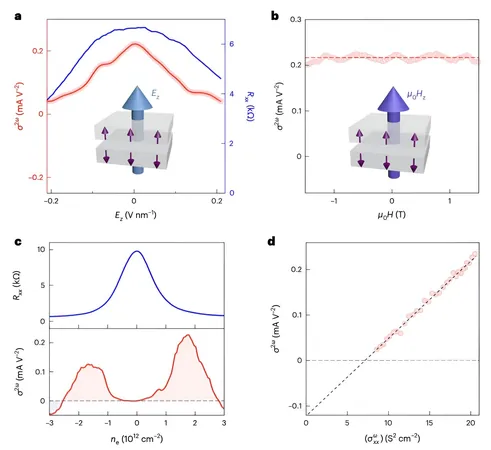
Groundbreaking Discovery: Antiferromagnetic Diode Effect Unveiled in MnBi₂Te₄ Sparks Hopes for Future Spintronic Technologies
2024-09-22
Author: Nur
Groundbreaking Discovery: Antiferromagnetic Diode Effect Unveiled in MnBi₂Te₄ Sparks Hopes for Future Spintronic Technologies
Exciting advancements in material science may shape the future of electronic and spintronic devices. Researchers from Harvard University have made a significant breakthrough by observing an antiferromagnetic diode effect in even-layered MnBi₂Te₄, a novel antiferromagnetic material. This discovery holds immense potential for cutting-edge technological applications due to its unique properties.
Antiferromagnets are distinguished by the alternating alignment of their magnetic moments, resulting in no net magnetism on a macroscopic level. This feature, while seemingly trivial, presents distinct advantages for implementing advanced technologies. The research team has discovered that MnBi₂Te₄, an antiferromagnetic topological insulator, exhibits a diode effect contrary to typical expectations. Unlike classic diodes, this material does not require a directional charge separation, which could revolutionize device design.
The implications of this discovery are extensive. The team demonstrated that the antiferromagnetic diode effect can be harnessed to create innovative electronic components such as in-plane field-effect transistors and high-efficiency microwave energy harvesting devices. The detailed findings were published in the esteemed journal, *Nature Electronics*.
Historically, diodes have played a pivotal role in the functioning of various electronic devices, from radio receivers to sophisticated digital circuits. The ability to control current flow in a single direction enhances the efficiency and functionality of these devices. Recent studies on non-centrosymmetric polar conductors further expanded the field by exploring superconducting diode effects, prompting researchers to investigate similar phenomena in antiferromagnetic materials.
The Harvard team experimented with two distinct electrode configurations while fabricating their devices, utilizing both Hall bar electrodes and radially distributed electrodes. Their observations of nonlinear transport in both setups confirmed the presence of the antiferromagnetic diode effect. Employing a range of advanced techniques, including spatially resolved optical methods and electrical sum frequency generation (SFG) measurements, they gained deeper insights into the material's properties.
In their findings, the researchers reported significant second-harmonic transport in devices linked to the compensated antiferromagnetic state of MnBi₂Te₄. This nonlinear electronic behavior opens up new avenues for device creation, particularly in developing antiferromagnetic logic circuits and efficient microwave energy harvesters.
The authors conveyed their enthusiasm about the potential applications of this antiferromagnetic diode effect, emphasizing its implications for upcoming advancements in quantum materials and spintronic devices. As researchers continue to explore this groundbreaking phenomenon, we may soon witness the emergence of new technologies that harness the remarkable properties of antiferromagnetic materials.
This discovery not only marks a turning point in material science but also ignites anticipation for the future of electronic devices that could be faster, more efficient, and environmentally sustainable.
Stay tuned as the realm of spintronics and electronics advances further into this electrifying territory!



 Brasil (PT)
Brasil (PT)
 Canada (EN)
Canada (EN)
 Chile (ES)
Chile (ES)
 Česko (CS)
Česko (CS)
 대한민국 (KO)
대한민국 (KO)
 España (ES)
España (ES)
 France (FR)
France (FR)
 Hong Kong (EN)
Hong Kong (EN)
 Italia (IT)
Italia (IT)
 日本 (JA)
日本 (JA)
 Magyarország (HU)
Magyarország (HU)
 Norge (NO)
Norge (NO)
 Polska (PL)
Polska (PL)
 Schweiz (DE)
Schweiz (DE)
 Singapore (EN)
Singapore (EN)
 Sverige (SV)
Sverige (SV)
 Suomi (FI)
Suomi (FI)
 Türkiye (TR)
Türkiye (TR)
 الإمارات العربية المتحدة (AR)
الإمارات العربية المتحدة (AR)